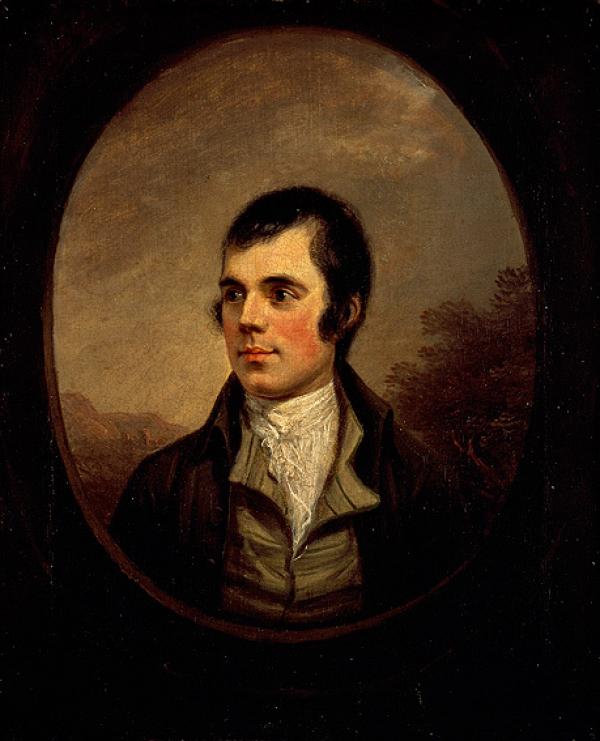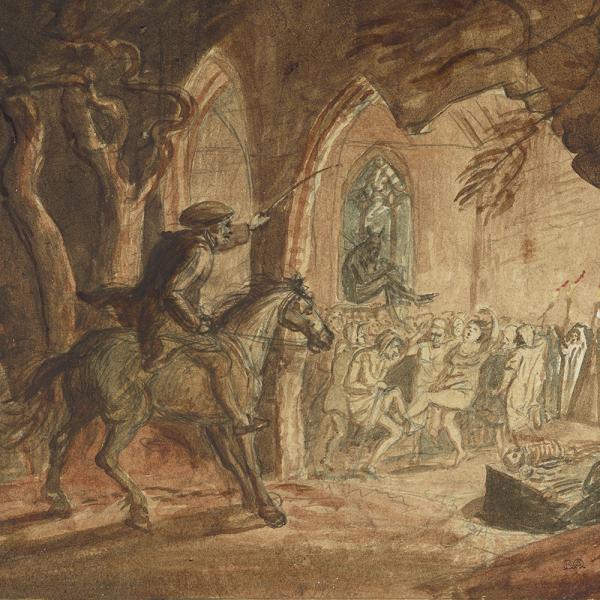Even 261 years after his birth, Robert Burns’s poetry remains resonant in its own right and as inspiration to others. Bob Dylan declared ‘A Red, Red Rose’ the lyric with the biggest impact on him; John Steinbeck’s Of Mice and Men takes its title from ‘To A Mouse’. Nowhere is safe from reproductions of his image either – typically after Alexander Nasmyth’s portrait which is on display at the Scottish National Portrait Gallery.
We have decided to shift the focus and show just how important Burns remains. Here, we present a selection of portraits in which Burns appears not as the main character but as having had a major impact on the sitter’s life and work.
George Thomson, collector of Scottish songs
George Thomson worked as clerk to the Board of Trustees for the Encouragement of Art and Manufactures in Scotland for most of his life, but in his free time he dedicated himself to collecting and publishing Scottish songs.
In 1793, he published the first volume of his Selection Collection of Original Scottish Airs including six songs by Burns, who continued writing songs for Thomson’s Collection until his death.
Thomson’s alterations to Burns’s work have made him a controversial figure in the world of Burns studies.
It is telling that in this portrait, he is not shown with his own biggest achievement, his Select Collection of Original Scottish Airs which eventually numbered six volumes, but with four volumes of ‘Burns’s Works’, emphasising his close association with the famous poet.
John Blackie, publisher
David Octavius Hill may now be best known as a pioneer of photography, but he started out as a landscape painter. His illustrations of places from Burns’s poetry were printed in The Land of Burns, published in 1840 by Blackie and Son. Appropriately, John Blackie is portrayed here leaning on a copy of that book.
The very first image which the reader would find when opening The Land of Burns is a print after Alexander Nasmyth’s portrait of 1787, due to ‘public sentiment having, after all, reverted to Nasmyth’s picture as the best’. The portrait had been commissioned from Nasmyth by Burns’ publisher William Creech and reproduced in print by John Beugo to illustrate the 1787 Edinburgh edition of his Poems, Chiefly in the Scottish Dialect. It went on to become the most widely reproduced image the bard and acted as the basis for the majority of Burns statues around the world.
The same prop appears in another photograph by Hill and Adamson, of Burns’s youngest son Colonel James Glencairn Burns.

John Miller Gray, art critic and first curator of the Scottish National Portrait Gallery
One print reproduction after Nasmyth is proudly displayed in John Miller Gray’s study.
Gray was an art critic and the first curator of the Scottish National Portrait Gallery.
The other portraits in the background are an image of Sir Walter Scott and what is thought to be a self-portrait by George Manson, about whom Gray had written a monograph.
The portrait shows Gray to be a studious man with an equal interest in both art and literature, unmistakably within a Scottish context.

James Pittendrigh Macgillivray, artist
In 1893, the town council of Irvine gave James Pittendrigh Macgillivray (1856–1938) his first major commission, for a statue of Robert Burns.
An amateur poet himself, Macgillivray worshipped Burns, making the photograph of the nine-foot statue towering over Macgillivray a particularly apt metaphor for Burns’s significance.
Macgillivray’s new studio had to be built to accommodate large-scale sculptures such as this one, with doors high enough to allow Macgillivray to manoeuvre them out of the studio so he could see their effect outdoors.
The statue was unveiled for the centenary of Burns’s death in 1896.

The Kelvingrove Eight
Eight leading contemporary Scottish writers are assembled in an imaginary room looking out over Kelvingrove Art Gallery and Museum in Glasgow, clearly anchoring this group in the west of Scotland.
True to Calum Colvin’s unmistakable style, the image is packed with props: books by the sitters and those who inspired them are stacked in front of a bookshelf and lying across the floor. In amongst the mix, the face of another distinguished writer hailing from the west peeks out from underneath a cushion: a book cover with a reproduction of Nasmyth’s painting of Robert Burns.
Colvin’s work often grapples with the construction of Scottish identity, and the image of Scotland’s national poet is a recurring element in his work.



